Exploring the Evolution and Impact of Color Block Long Sleeves
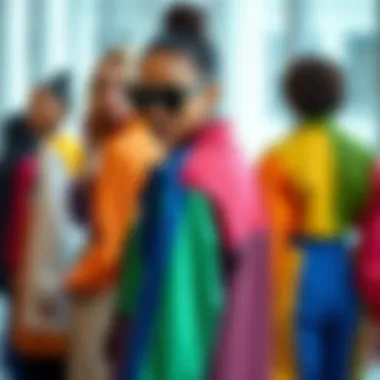

Intro
Color block long sleeve attire has surged in popularity and relevance, resonating with both fashion enthusiasts and professionals alike. This style captures bold aesthetics, individual expression, and a unique narrative in the broader context of today’s fashion landscape. It represents not just a trend but a reflection of evolving tastes and cultural shifts.
Diving into the historical journey, one can trace the roots of color blocking back to the avant-garde art movements of the early 20th century, which aimed to challenge traditional design and aesthetic norms. This laid the foundation for a design principle that is both striking and versatile, eventually weaving its way into the fabric of modern apparel. With color block designs, layering and arrangement of colors yield a visual stimulation that draws the eye and allows the wearer to express personal style.
As we venture further, we will explore not only the aesthetic appeal of color block long sleeve garments but also their significance in relation to sustainability and ethical fashion practices, a topic that has garnered increasing attention in recent years. This exploration is essential for understanding the multifaceted nature of color block attire and its place within the evolving tapestry of fashion.
Understanding Color Blocking
Color blocking is a fascinating design technique that harnesses the power of color to create bold, eye-catching garments. This section delves into the intricate elements that define color blocking, highlighting its significance in the realm of fashion, particularly within long sleeve attire. By understanding color blocking, one can appreciate its transformative potential in crafting garments that are not only visually striking but also carry layers of meaning.
Historical Context of Color Blocking
Origins in Art Movements
The roots of color blocking can be traced back to prominent art movements, particularly in the early to mid-20th century. Movements such as Cubism and Abstract Expressionism played a pivotal role in shaping how color could be used to convey emotion and alter perceptions. Artists like Piet Mondrian famously used geometric shapes filled with solid colors to create harmonious yet contrasting compositions. This artistic approach has left a lasting impact on various fields, including fashion.
Color blocking serves as an ode to these artistic influences by allowing designers to break free from monotony. It encourages the use of vivid colors in unexpected pairings, bringing an invigorating energy to garments. Such creativity not only showcases a designer's artistic vision but also resonates strongly with wearers, adding a personal touch to their style. One might consider this approach equal parts daring and expressive, making it immensely appealing in today's fashion landscape.
Transitions into Fashion Design
The transition of color blocking from art to fashion design marks a significant twist in the narrative of style evolution. In the 1960s and 70s, as abstract art gained prominence, fashion designers began to adopt these bold applications of color, often integrating unexpected combinations into their collections. Designers like Yves Saint Laurent and Pierre Cardin embraced color blocking to craft garments that challenged traditional aesthetics and provided a fresh perspective on elegance.
This infusion of artistic inspiration into fashion design has proven to be beneficial. By incorporating distinct color blocks, designers allow for a form of expression that transcends fabric. This unique feature promotes individuality while enabling wearers to play with styles that reflect their personalities. However, it's worth noting that striking a balance in color blocked designs can require a nuanced understanding of color theory—a skill not all designers possess. Thus, while color blocking can open doors to creativity, it can also present challenges if not executed thoughtfully.
Core Principles of Color Blocking
Contrast and Harmony
At the heart of color blocking lies the principle of contrast and harmony. This interplay between opposing colors—like the bold clash of bright yellow against a deep royal blue—creates visual interest and can elicit emotional responses. Designers utilize stark contrasts to capture attention or create focal points in their creations. Conversely, harmonizing colors can bring a sense of warmth and balance, making the outfit approachable yet stylish.
Color blocking being dynamic makes it an excellent choice for long sleeve designs, where the additional fabric area allows for more bold explorations. Whether it’s a classic A-line silhouette or a contemporary oversized design, the application of contrasting colors effectively turns a simple garment into a statement piece. Understanding this principle is crucial for fashion enthusiasts and professionals looking to make their mark in the industry.
Color Theory Applications
Color theory, which involves understanding how colors interact with each other, plays a significant role in effective color blocking. Various color combinations—complimentary, analogous, or triadic—serve as essential tools for designers. This grasp of color relationships empowers professionals to create garments that not only please the eye but also evoke a particular vibe.
Within the context of long sleeve attire, color theory can guide decisions on fabric choice and garment layers. An individual wearing a long sleeve top with complementary colors can create an outfit that feels harmonious and cohesive. However, misapplications of color theory could lead to a garment that is overwhelming or clashes in undesirable ways. Thus, mastering this theory can ultimately be the difference between a well-executed color block design and a confusing visual.
"Balancing colors is like juggling—too many in the air and you might drop a ball, yet with just the right amount, it becomes an artform."
In summary, understanding color blocking is not only about visual appeal; it’s about comprehending the intersections of art, design, and emotional resonance. This foundation allows designers and wearers alike to harness color's full potential, paving the way for innovative long sleeve attire that speaks volumes without uttering a single word.
Long Sleeve Garments: An Overview
Long sleeve garments have carved out a significant niche in the clothing landscape, thanks to their versatile nature and adaptability across various contexts. Importantly, they straddle the line between practicality and aesthetics, making them an essential staple in wardrobes around the world. From casual outings to formal engagements, long sleeves provide a plethora of choices that can either blend in or stand out, depending on how one styles them.
Historical Development of Long Sleeves
Function vs. Fashion
When it comes to the dynamics of function versus fashion in long sleeve garments, one must consider the dual role these items play. On one hand, long sleeves serve practical purposes: they offer warmth in colder months and protect the skin from sun exposure. These functional attributes have historically been vital for outdoor laborers and those living in harsher climates. Thus, the ability to combine utility with style makes long sleeves a compelling choice.
On the flipside, the fashion aspect cannot be overlooked; long sleeves are often seen as more polished and sophisticated. Styles range from the relaxed fit of a casual tee to the tailored elegance of a dress shirt, showcasing how this item can cater to diverse tastes.
The unique feature of this duality is indeed beneficial in today’s mixed-use lifestyle. People desire clothing that matches both their day-to-day practical needs while also allowing them to express their personal style. Nevertheless, one should note that not every long sleeve works for every occasion, thus requiring a nuanced understanding of the garment.
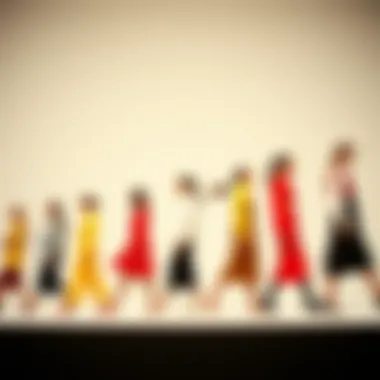
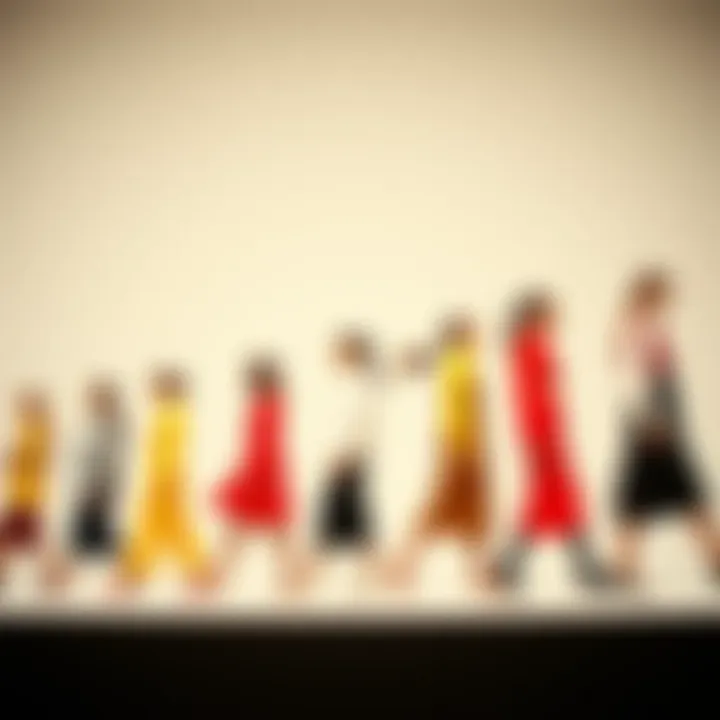
Evolution Through Eras
The evolution of long sleeves across various eras reflects broader social changes. From the billowing sleeves of medieval garments to the streamlined silhouettes of modern designs, this evolution mirrors advancements in fabric technology and changing fashion sensibilities. The passage of time has seen long sleeves transform—from purely functional pieces to expressions of personal identity and social status.
In the 19th century, the advent of industrialized textiles allowed for more intricate designs, leading to the creation of tailored long sleeves that embodied opulence. Fast forward to the present, where sustainability and comfort now drive design trends, showcasing how long sleeves have adapted to current consumer values.
The advantage of this evolution lies in the accessibility of long sleeve options for a wider demographic, catering to all body types and preferences. However, as fashion continues to evolve, there's always the risk that certain styles may become outdated, necessitating a constant reevaluation of what fits into contemporary wardrobes.
Types of Long Sleeve Designs
Casual Versus Formal
In examining casual versus formal long sleeve designs, one uncovers how these garments cater to distinctly different atmospheres. Casual long sleeves, such as simple t-shirts or relaxed fit tops, offer comfort and ease, enabling individuals to express themselves effortlessly. They are typically characterized by relaxed patterns and materials that reflect leisure and everyday wear.
On the other hand, formal long sleeves, like dress shirts or blazers, emphasize structure and sophistication. These designs are constructed from luxurious materials and feature tailored cuts, showcasing a polished appearance suitable for professional and formal events.
Both casual and formal long sleeves have unique advantages; casual designs encourage self-expression and comfort, while formal options enhance professionalism and elegance. Each serves its purpose, but understanding when to wear which is key to successfully navigating varied social settings.
Seasonal Styles
Seasonal styles in long sleeve garments further emphasize their adaptability. In autumn and winter, these sleeves can come thick and cozy, made from materials like wool or fleece, perfect for layering and insulation. Bright colors may take precedence in spring, whereas darker, rich hues often dominate during fall, aligning with seasonal mood shifts.
The unique feature of seasonal styling is its ability to engage with broader fashion trends while addressing the practical need for warmth and coverage. This adaptability is often a favored characteristic, allowing creative expressions through color combinations and fabric choices catering to the changing climates.
However, it’s crucial to balance seasonal trends with timeless pieces. While disposable fast fashion may entice buyers to follow the trend of the moment, quality long sleeve garments invested in either seasonal or all-year-round styles can provide lasting value. Properly curated, they can foster a wardrobe that not only caters to aesthetic desires but maintains a consciousness of sustainability in fashion.
Color Block Long Sleeve: Design Perspectives
The significance of color block long sleeve attire shines through in its ability to blend aesthetics with personal expression. Color blocking is not merely about slapping a few colors together; it stands as a bold statement of individuality and can elevate one's entire look. It reflects creativity and offers versatility. This section navigates the intricate pathways of designing these garments, focusing particularly on fabric selection, patterns, and how they contribute to the overall appeal of color block long sleeves.
Crafting Color Block Long Sleeve Attire
Fabric Selection and Its Impact
The choice of fabric in color block long sleeve attire is of utmost importance. Different materials carry different vibes. For instance, cotton lends a casual, breathable quality while linen adds a touch of elegance. Synthetic fibers, on the other hand, are popular for their vivid hues and durability. Each fabric comes with its own set of characteristics that can vastly alter the garment's appearance and its wearer's experience.
When considering fabric, it is essential to take into account the key characteristic of breathability. A breathable fabric allows for comfort, particularly in warmer climates, making it a popular choice for everyday wear. One unique feature of cotton blends, for example, is their ability to hold color exceptionally well while remaining soft against the skin, a winning combination when crafting color block designs. However, one must also be aware of potential downsides; synthetic fabrics can sometimes feel less comfortable over extended periods, especially if they lack moisture-wicking properties.
Patterns and Visual Balance
Patterns play a critical role in the aesthetic appeal of color block long sleeves. They are instrumental in achieving visual balance, a concept that ties back to foundational design principles. A well-thought-out pattern arrangement can guide the eye across the garment, creating a harmonious look. For instance, mixing geometric patterns with solid blocks can add depth and intrigue to a piece, breaking monotony and inviting closer inspection.
The key aspect of good pattern design is its capacity to enhance or distract. A successful color block outfit employs patterns that complement rather than compete with each other. This practice makes it a beneficial choice for achieving visual artistry in modern fashion. However, designers must tread carefully; an over-complicated pattern can overwhelm the overall look, defeating the purpose of the color block itself. By balancing patterns with carefully chosen colors, designers can create eye-catching garments that make a lasting impression.
Styling Color Block Long Sleeves
Pairing with Bottoms and Footwear
The way color block long sleeves are paired with bottoms and footwear creates a complete ensemble. Think of it as a dance; the top needs to flow seamlessly with the other elements. The important thing to note here is the contrast in styles. A causal color block top can be beautifully offset with tailored trousers, for instance. This blend of the informal with the formal is an effective way to create a balanced look.
In choosing how to style the bottom, consider the silhouette. A fitted pair of jeans can elongate the legs and complement a structured top, making for a balanced outfit. Additionally, footwear selection carries weight. Wearing strappy sandals offers a fresh, summery vibe, while boots can evoke a more grounded aesthetic. However, be wary of color clashing; it can easily draw attention for the wrong reasons. Aim for complementary or monochromatic schemes to maintain cohesion.
Layering Techniques
Layering is a stylish way to add depth to color block long sleeves. It allows the wearer to play with textures and styles, making it easy to adapt to various occasions. A lightweight cardigan over a bright color block top adds warmth and sophistication, while still reflecting a modern vibe. One key characteristic of layering is its flexibility in transitioning between seasons. A long sleeve can be stylishly paired with a light jacket, making it versatile for cooler evenings.
Moreover, layering can aid in accentuating colors strategically. For example, if a color block long sleeve has shades of blue and green, a neutral jacket can help those colors pop even more. However, it is essential to maintain balance. Too many layers can lead to a bulky appearance and detract from the intended visual statement of color blocks. Choose layering pieces that fit well and complement the main garment.
Overall, attention to fabric selection, patterns, and styling techniques collectively guide the creation of impactful color block long sleeve garments. By focusing on these elements, designers not only enhance visual appeal but also contribute to the cultural dialogue surrounding fashion in contemporary society.
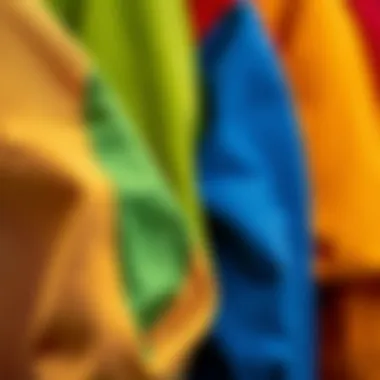
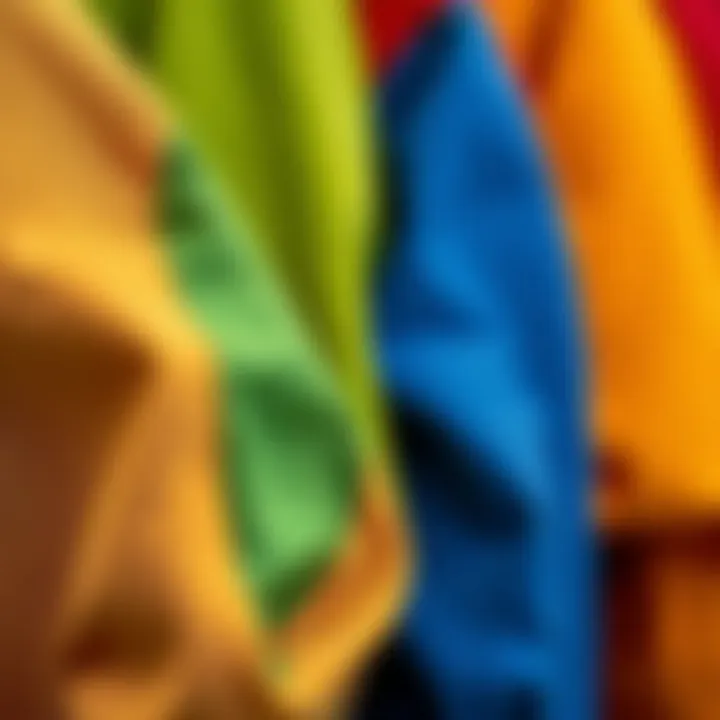
Cultural and Social Implications
Color block long sleeve attire is not merely a fashion statement; it delicately intertwines with cultural narratives and social dynamics. Understanding these implications offers insight into not just how we dress, but why those choices resonate in a broader context. The colors we wear communicate emotions, beliefs, and identities while also reflecting societal norms and shifts. As such, these garments do not exist in isolation but play a significant role in the ongoing dialogue of our time.
Cultural Significance of Color Usage
Colors and Their Cultural Interpretations
Colors carry profound meanings across different cultures, affecting how individuals perceive and react both socially and personally. For instance, red might signify love or passion in many Western cultures but could represent danger or luck elsewhere, such as in China.
What makes this concept especially relevant in color block design is its ability to overlap these interpretations, merging them into a visual language that speaks to a diverse audience. The dual nature of colors allows designers to tap into rich cultural fabrics through simple fabric choices. In essence, the colors we choose in our color block garments often serve as a silent social commentary or personal expression, making it a compelling focal point in contemporary fashion discussions.
Some unique features of understanding color interpretations include:
- Cultural Diversity: Incorporating various color meanings respects and celebrates cultural diversity.
- Emotional Communication: Colors can evoke strong feelings, making them powerful tools in fashion marketing and personal branding.
However, this complexity also comes with potential pitfalls. Designers must be aware that misrepresenting color meanings can lead to unintended offense or cultural appropriation. Thus, navigating this colorful minefield requires thoughtfulness and an informed approach.
Expression Through Fashion
Fashion is a potent form of self-expression, and color block long sleeves exemplify this intersection beautifully. By mixing colors deliberately and creatively, individuals can convey aspects about their identity, mood, or belief system. Wearing a vibrant, color-blocked outfit might express confidence, creativity, or a rebellious spirit, while more muted tones can signal sophistication or professionalism.
The unique characteristic here is that expression is multifaceted; it can shift depending on context, audience, or even the day’s mood. For example, a casual outing might call for bold hues paired in innovative ways, while a workplace environment could prompt a more subdued palette. This versatility makes color block long sleeves adaptable to various situations, appealing to a broad audience.
Considerations in this regard include:
- Personal Identity: Color choices can serve as a form of personal branding, impacting how one is viewed socially and professionally.
- Artistic Freedom: Fashion enthusiasts appreciate the freedom to play with colors and forms, continually redefining their personal styles.
Yet, expressing oneself through clothing is not without challenges. Some may question the appropriateness of certain combinations, or whether their color choices may be misunderstood in particular settings.
Influence of Social Media and Celebrity Trends
Emerging Influences in Style
Social media platforms play a vital role in shaping contemporary fashion trends, providing rapid accessibility to diverse styles and color combinations. Users indulge in platforms like Instagram and Pinterest to explore and expand their wardrobes, resulting in emergent trends that often fuel collective expressions.
The democratization of fashion through these platforms creates a culture where what was once reserved for the runway becomes available to the everyman. Emerging influencers use color block long sleeve garments to showcase not only their individuality but also their affiliations with specific movements or communities.
Benefits of this trend include:
- Wider Reach: Emerging designers and consumers wield significant power, enabling creativity to flourish beyond conventional fashion industry limits.
- Cultural Exchange: The blending of styles from various regions leads to a richer and more eclectic fashion scene.
However, these trends can also dilute originality, as everyone strives to replicate what is deemed popular. Inadvertently, this can stifle personal expression and create a somewhat homogenized visual culture.
Impact of Fashion Icons
Celebrity influence remains a strong driving force in the fashion world. Stars like Beyoncé, Rihanna, and Harry Styles often make headlines not just for their work but for the outfits they don. Color block long sleeve garments become highly sought commodities when donned by such icons. Fans emulate their styles, believing that mimicking their favorite star's outfit will invoke a piece of their charisma.
This phenomenon is significant for several reasons:
- Trendsetting: Celebrities mold public perception and dictate what is ‘in’ or ‘out’. When they embrace color blocking, it simultaneously legitimatizes the trend and sparks dialogues on its cultural relevance.
- Commercial Success: Brands that align with these icons often witness a surge in sales directly correlated with celebrity endorsements, showcasing the economic aspects of fashion.
Nevertheless, such reliance on celebrity trends can be problematic. It raises questions about authenticity and the pressure individuals feel to replicate what they see, which can lead to a resistance against personal creativity.
Understanding these cultural and social implications not only enhances our perspective on color block long sleeve attire but also connects fashion to the wider societal fabric, revealing much about our values, influences, and identities.
Sustainability in Color Block Fashion
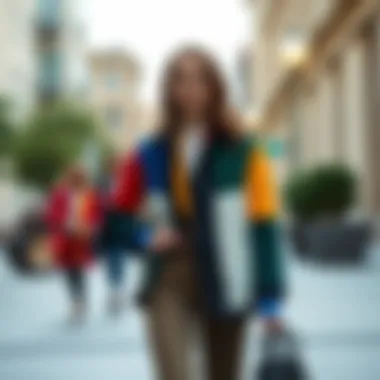

In the contemporary fashion arena, sustainability isn't just a buzzword; it's a guiding principle. The rising awareness about environmental issues has impelled both designers and consumers to reconsider the way they approach fashion. Several factors contribute to the significance of sustainability in color block long sleeve apparel. Whether it’s the fabrics used or the production methods adopted, every choice has ramifications beyond mere aesthetics. Sustainability functions as a bridge between style and conscience, engaging a more discerning consumer base that values eco-friendly options.
Ethical Sourcing of Materials
Environmental Considerations
Today's garment industry is notorious for its adverse impact on the environment, often using methods that deplete natural resources and generate waste. Ethical sourcing emphasizes the procurement of materials in a way that minimizes ecological footprints, thus aiming to protect our planet's health. This concept is especially central to color block long sleeve designs, as diverse fabrics play a key role in creating vibrant combinations. Using materials like organic cotton or recycled polyester not only offers benefits in terms of durability but also reduces harmful emissions associated with traditional fabric production.
The significant characteristic of environmental considerations lies in their focus on sustainable practices—promoting greener alternatives that can be beneficial for both the planet and the consumer. What's more, employing eco-friendly fabrics has the added advantage of appealing to a conscious market that seeks to support brands with sustainable values.
Responsible Manufacturing Practices
Responsible manufacturing practices go hand in hand with ethical sourcing. They ensure that the entire production process is executed with a mindset focused on social and environmental responsibility. This involves maintaining safe working conditions, fair labor practices, and utilizing operational efficiencies that lessen energy use. A product crafted with care not only looks good but feels good in the hands of its wearer, contributing to an overall positive experience.
By adopting responsible practices, brands can build consumer trust and foster loyalty. For instance, reducing waste through methods like zero-waste pattern making is a unique feature gaining traction in the industry. However, it requires a shift in traditional production methods, which can pose challenges. Still, the potential rewards—like appealing to ethically-minded customers—often outweigh the hurdles.
Sustainable Styling Tips
Durable Fashion Choices
When it comes to styling, durability cannot be overstated. Seeking long-lasting garments within the realm of color block design means prioritizing fabrics that withstand wear and tear while retaining their vibrancy. This leads to more sustainable purchases as well, since consumers may not need to replace items as frequently. Garments made from strong materials not only provide better value but also encourage a culture of investment over fast fashion consumption.
A significant benefit of durable choices is their ability to transition through various occasions—be it an office setting or a casual outing. This versatility means that consumers can effectively reduce their wardrobe sizes, culminating in less waste. Moreover, the unique feature of durability is that it often correlates with timeless designs, which can ultimately yield cost savings for the consumer in the long run.
Timeless Wardrobe Essentials
Timeless wardrobe essentials are quintessential pieces that outlast fleeting fashion trends. These items integrate seamlessly into the overall ethos of sustainability by reducing the impulse to buy into every passing fad. Color block long sleeve garments that embody classic silhouette styles fit this description. They can be paired effectively with different outfits, making them valuable assets in any wardrobe.
The attractiveness of timeless essentials resides in their enduring appeal, ensuring consumers wear their purchases longer. This approach promotes more mindful consumption—buyers learn to value their clothing rather than see it as disposable. However, identifying true timeless pieces takes consideration and may require investment upfront. Ultimately, the journey toward a sustainable wardrobe starts with recognizing the importance of such staples.
Future Trends in Color Block Long Sleeves
As fashion continually evolves, color block long sleeves find themselves at the forefront of new and exciting trends. It's important to consider how shifting aesthetics and technological advancements influence both design and consumer choices. Embracing these changes helps not only in aesthetic appeal but also in providing functional attributes, aligning fashion with the immediate needs of modern life.
Emerging Color Combinations
Forecasting Popular Colors
When discussing forecasting popular colors, it's crucial to recognize the connection between color psychology and market response. A shift toward particular hues can stem from various influences — cultural markers, celebrity endorsements, or even global events. For example, the embrace of earthy tones following the pandemic reflects a collective desire for groundedness and comfort in our attire.
The popularity of pastel colors, more specifically, has become a beacon of hope in the uncertainty of today. These soothing shades are versatile, capable of brightening up an outfit without overwhelming the senses. They fit seamlessly into casual long sleeve designs while maintaining a sense of sophistication. Each combination offers a unique edge, inviting wearers to explore their personal style and confidence.
However, while appealing, emerging color combinations have their drawbacks. Brands may find it challenging to balance trendy colors with timeless designs; trends can be fleeting, and attempts to keep up can dilute brand identity.
Seasonal Trends and Influences
Seasonal trends and their influences are a vital dynamic in the world of color block long sleeves. Each season introduces new palettes inspired by nature’s phases, cultural events, and socio-political shifts. For instance, the vibrant colors that often adorn summer collections signify energy and the joy of self-expression. This aligns perfectly with the bright, bold combinations typical of color blocking.
The key characteristic of this aspect lies in its cyclical nature. As summer brings lively colors, winter often means a shift back toward muted or darker tones, echoing the environmental changes around us. This ongoing dance between seasons not only enhances aesthetic appeal but also maintains relevance with the public's shifting moods and preferences.
However, relying solely on seasonal influences can create a double-edged sword. If consumers get accustomed to this rhythm, they may find themselves drawn only to what is currently trendy, overlooking the classic potentials of color block designs.
Innovations in Fabric Technology
Smart Fabrics and Their Implications
The exploration of smart fabrics offers an enticing glimpse into the future of color block long sleeves. These textiles are engineered not just for aesthetics but also for functionality, adapting to the wearer's needs. Fabrics that can change color based on temperature or lighting provide a unique opportunity to innovate traditional designs, enhancing the essence of color blocking with dynamic features.
This new technology allows consumers to express themselves in innovative ways, showcasing versatility through color. However, the complexities of production and potential costs may deter some brands from adopting these technologies, resulting in a gap between high-end fashion and accessibility.
Revolutionizing Comfort and Style
When addressing revolutionizing comfort and style, it's essential to acknowledge how this shift is drastically changing consumer expectations. Long sleeves, traditionally seen as either too bulky or too formal, can now bring together style and comfort through innovative designs and materials. The introduction of moisture-wicking fabrics and stretchable materials in color block design enhances both usability and visual appeal.
With consumers increasingly valuing comfort in their daily wardrobe, this feature is essential for long sleeve garments to stay relevant in fashion. But while comfortable clothing often becomes a priority, care must be taken to ensure that style does not take a backseat. Finding the right balance can elevate a design from mundane to standout.







